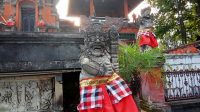GORGEOUS statues can be easily found on Bali Island. Statue of Lord Ganesha, for instance, is one of the most revered gods in Hinduism. It does not only have deep spiritual value, but also aesthetic beauty that can enrich landscape and garden art.
As a symbol of wisdom and protection, Ganesha statue is often placed in various areas of homes, temples, and gardens, thus providing harmony between spirituality and visual beauty.
Ganesha Statue Materials
The statue of Lord Ganesha can be made from various materials that reflect different traditions and aesthetic values. Some commonly used materials are:
Stone: One of the most commonly used materials in Bali. Stone gives a natural and classic impression, making the Ganesha statue look like it blends in with the traditional Balinese landscape.
Wood: Ganesha statues carved from wood often show fine carving details. The wood used usually comes from hardwood types such as teak or suar, which are very durable and give a warm and natural impression to the garden or space.
Bronze and Metal: In modern sculpture art, Ganesha statues are also made from metals such as bronze. These metal statues are often found in contemporary styles or gardens that have modern elements.
Ceramic and Terracotta: Ganesha statues made of ceramic or terracotta are often placed in garden areas or outdoor spaces as decorative elements. These materials provide natural textures and colors that can enhance the tropical or rural feel.
Philosophical and Religious Meanings
Ganesha is known as the god of wisdom, protection, and the remover of obstacles. Each element of the Ganesha statue has a deep symbolic meaning:
Elephant: Ganesha’s elephant-shaped head symbolizes wisdom, strength, and patience. Elephants are also known as animals that can open paths, which is in accordance with Ganesha’s meaning as the god of removing obstacles.
Trunk: Ganesha’s trunk, which is often seen pointing towards a pot or flower, symbolizes the ability to adapt to various situations and challenges in life.
Big Belly: Ganesha’s big belly symbolizes the ability to accept and absorb everything, both positive and negative, wisely.
Hand Holding a Rope: Ganesha is often depicted holding a rope or prayer beads, symbolizing man’s efforts to achieve a higher spiritual goal.
For Hindus, a Ganesha statue is a powerful object of reverence. Placing a Ganesha statue in a garden or outdoor space is often accompanied by a ritual or prayer for protection, wisdom, and smoothness in all affairs.
Landscape Art and Ganesha Statues
In landscape art, Ganesha statues are often used to enhance the aesthetics of a garden or outdoor space. Ganesha brings a spiritual element into a calm and peaceful area, creating a space that is not only visually beautiful but also meaningful.
Placement at the Entrance: One common way is to place a Ganesha statue at the entrance of a garden or building. This symbolizes protection, guarding the area from negative energy and bringing good luck to those who enter the place.
Water Garden: Ganesha statues are often placed near ponds or water elements in the garden. Water, as a symbol of purity and life, adds a dynamic element to the statue, while Ganesha maintains spiritual balance. The presence of the water element also provides a calming natural sound, enhancing the meditative feel.
Meditation Zone: Ganesha statues are often placed in meditation areas or quiet seating areas in gardens. These spaces become areas where one can meditate, reflect, and seek inner peace while surrounded by natural beauty and spiritual meaning.
Aesthetics in Gardens
Aesthetically, Ganesha statues add an artistic element and uniqueness to the garden landscape. Their harmonious design, detailed carvings, and strategic positioning can enhance the desired feel, whether it is a peaceful, exotic, or even monumental atmosphere. The presence of Ganesha statues in gardens also creates an interesting visual focal point, impressing visitors with the blend of nature, art, and spirituality.
Lighting: Proper lighting of Ganesha statues, especially at night, can add a dramatic dimension to the garden. Soft spotlights that focus on Ganesha’s face or body create shadows that highlight the spiritual power of the statue.
Integration with Plants: Ganesha statues are often integrated with surrounding vegetation, be it greenery, trees, or flowers. This combination enhances the harmonious impression between humans, nature, and spirituality.
Conclusion
Ganesha statues not only function as religious symbols, but also have high artistic and aesthetic value in landscape art. With diverse materials, deep philosophical meanings, and In enriching the beauty of the garden, the Ganesha statue becomes an important element that is able to unite spirituality, art, and nature.
Its presence in the garden not only enhances the visual beauty, but also provides peace and protection for those around it.










